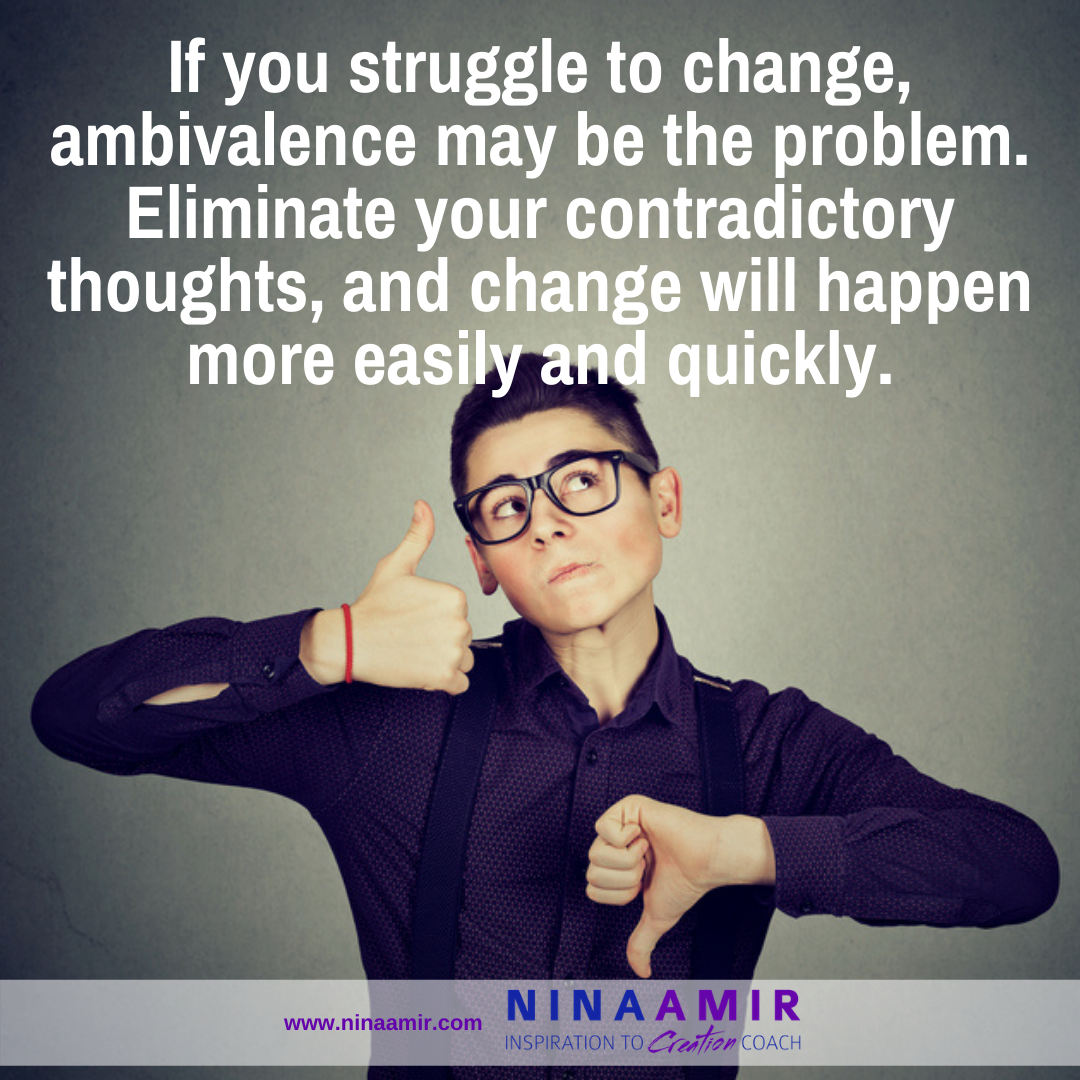 You really want to change. You’ve focused on self-improvement.
You really want to change. You’ve focused on self-improvement.
Your home is littered with self-help books. You spend all your extra money and time on personal and spiritual growth courses, webinars, and coaching programs in an attempt to level up your performance in a variety of life arenas.
Yet, you still struggle to make even small changes in yourself and your life. It seems like no matter what you try, your habits, mindsets, and results remain the same.
What’s the problem?
You are Ambivalent
You are ambivalent about change—even though you say you want it. Specifically, you have mixed thoughts and feelings about the changes you claim to want.
Ambivalence is the state of having mixed feelings or contradictory ideas about something or someone. When it comes to change, existing in that state stops you from achieving transformation.
To achieve anything—including a personal change, you have to have clarity. Ambivalence wrecks havoc on clarity because your conflicting thoughts and feelings make it hard for you—or the Universe—to know what you really want.
Ambivalent to Change
You probably don’t realize you are ambivalent about the changes you claim to want. You say you want something, when, in fact, you aren’t sure.
On the one hand, for example, you would love to lose 20 pounds. On the other hand, you don’t want to give up eating ice cream every night.
You want a better relationship with your significant other. Yet, you don’t want to let down your walls and be open and vulnerable.
You want a promotion and a bigger paycheck each week. Still, you don’t want the additional responsibility and stress that go with that new position.
You want to be successful, but you don’t want success to change you or your life.
Do you understand now?
Seeing Both Sides
Think about any change you want to make—but haven’t accomplished yet, and I bet you can see the change from two sides.
Positive vs. negative. Want vs. Don’t Want. Pro vs. Con.
You are ambivalent. And that ambivalence prevents you from achieving the change you desire.
Why Don’t I Change?
I was having a conversation with a friend when this became super clear to me. We were both bemoaning the fact that the changes we wanted weren’t happening.
As a Certified High Performance Coach and long-time spiritual and personal growth junkie, I knew how to change. However, I still wasn’t succeeding in my efforts to change. My friend, who is a therapist and Certified High Performance Coach, had the same issue.
And then it hit me: “The things I want to change I also do not want to change. Or I’m afraid to change.”
“Exactly,” she said. “We are ambivalent.”
For example, I want to build my business, but I want more time to write. If I spend time building my business, I have less time to write. (Plus, the more successful my business, the more time I believe it will take up.)
I want to lose 15 pounds, but I really love my ice cream. (Yes, the example above was my own…) I want to be thinner, but I do not want to give up dessert.
As we talked, I realized why I felt so stuck and unable to change. I couldn’t make up my mind. My desires conflicted. I felt ambivalent. Therefore, no matter how hard I try to change something in myself or my life, it just doesn’t happen.
Remove Contradictory Thoughts
If you are ambivalent, wanting one thing more than you want the other will not solve the problem. You have to remove the contradictory thoughts entirely. Until you do, you continue to give the Universe mixed messages, and your ambivalence will continue to thwart your efforts.
As one thought becomes more dominant, however, creating change does become easier. But change won’t come easily and quickly until you are clear about what you really want and decide you want it without any doubt, misgivings, or fear—without contradiction.
You have to be certain you want a change. Period. Only with certainty can you create change—long-lasting change.
Uncover Your Contradictory Thoughts
If change feels challenging, it’s highly likely that what you say you want you also do not want. Therein lies the problem. Your contradictory thoughts keep you stuck.
Uncovering contradictory thoughts can be tricky, though. Usually, you aren’t aware you even have ambivalence. While I am acutely aware of some of mine, some remain in blind spots or deeply hidden in my subconscious.
So, I started thinking about how to resolve my own ambivalence and, finally, change. I created a process that used powerful questions and high-performance ranking to help you move toward transformation by uncovering and resolving contradictory thoughts.
Give it a whirl and see if it helps. (Let me know in a comment below.) You’ll need a journal or new document on your computer and a bit of time for this exercise.
How to Reduce—or Remove—Ambivalence
First, use these four steps to get to the root of your ambivalence.
- Identify an area of your life where you are struggling to make a change.
- Make a list of the reasons you want to make that change.
- Make a list of the reasons you don’t want to make the change.
- For each reason—pro or con—rank the intensity of your belief in that reason. (Use a scale of 1 to 10 with 10 being the strongest.)
You now have a clear picture of your state of ambivalence. If you have only a few reasons you don’t want to change and many reasons you do, awesome! If you have a longer list of reasons not to change, you’ve got some work ahead of you.
But the reasons that you ranked six or above are the ones to which you want to pay attention.
Increase Clarity to Get to Certainty
Second, gain a bit more clarity. For each reason you ranked a six or higher, answer this question: What’s the worse or best case scenario?
In other words, if you want to receive a promotion but don’t want the added responsibility, ask:
- What’s the worst thing that would happen if I got the promotion?
- What’s the best thing that would happen if I got the promotion?
Dig deeper after answering those questions by answering this one: If that happened, how would it change my life for better or worse?
Then, answer these two questions:
- If the worst thing happened, what could I do?
- What positive outcome or opportunity might that reveal?
Your answers will give you clarity, and clarity leads to certainty. When you realize a negative outcome might not be so bad or that you can deal with it—and it might even lead to something good, you are more likely to make the change. You become certain that the change is safe, positive, and worthwhile. You negate all the negative thoughts you have about the change.
Is This True?
Let’s take this exercise one step further. Sometimes we hold onto old beliefs, and these make it hard for us to change.
For instance, my mother told me that making a career as a writer is hard and doesn’t pay much. When I think of trying to make a living as a writer—and giving up everything else I do for income, I hear her voice in my head. And I feel afraid to make the change—to write full time.
But if I ask myself, Is this true?, the answer is no. Some people make a living from their published words. When I realize what she told me—and I chose to believe—is not true, I reduce my level of ambivalence.
The negative thoughts from the past hold you back. Unfortunately, too many of them are unconscious. That means you have to uncover them to reduce your ambivalence.
Uncovering the Source of Ambivalence
Often our unconscious thoughts stem from childhood. We are told something by someone of influence, and decide to believe them. Then we carry that belief with us through life, never asking if it is true for us.
To reduce ambivalence, uncover the source of it. Take each one of the reasons you don’t want change—especially the ones you ranked six or higher—and ask yourself:
- Who taught me that?
- Do I know it is true?
- Am I trying to prove them right?
- What if I proved them wrong?
This exercise will help you dispel some of these myths. In the process, you’ll gain more clarity and become certain about the positive effects of the change you desire.
Get Out of Your Comfort Zone
Last but not least, determine if your struggle to change originates from the fact that change feels uncomfortable. Not only does it take you out of our comfort zone, but change often feels difficult.
That’s enough reason for ambivalence. Comfortable vs. Uncomfortable? Most people opt for comfort—even if they say they want to change.
Look over your reasons for not changing. How many of them will take you out of your comfort zone?
Consider this: *Is it better to be in your comfort zone feeling uncomfortable because you haven’t changed or in an uncomfortable zone feeling great about finally taking steps toward change?
Living in your comfort zone will keep you comfortable. But change happens in the uncomfortable zone. As long as you are ambivalent about feeling uncomfortable, you won’t change.
Keep this in mind: change doesn’t stay uncomfortable. Over time, that uncomfortable stage of change becomes comfortable.
Plus, if you are uncomfortable enough in your comfort zone, you might find change brings a much higher comfort level. Think about that… You might feel more comfortable once you change. That realization that could remove a lot of ambivalence.
If you really want change—and have struggled to achieve it, reduce your ambivalence. You’ll soon see your efforts getting results.
In which areas of your life does ambivalence stop you from creating change? Tell me in a comment below—and share your results after using the process explained above. And…please share this post with a friend or on your social networks.
Never miss one of my videos! Click here to subscribe to my YouTube channel.
Are you ready to make some big changes? Give me an hour or so of your time, and I’ll help you gain some clarity and certainty so you start moving toward transformation faster. In the process, you’ll take huge strides toward fulfilling your potential and purpose, realizing your dreams, and becoming the best version of yourself. You know you can be more…do more…achieve more…contribute more. And it’s time to do that. Apply for a FREE breakthrough strategy session. Fill out this application.
 Or register for my Certified High Performance Group Coaching program here. This is a great option if you don’t feel ready for one-on-one coaching and want to enjoy the power of group learning. This program features the connection provided by community and requires a lower investment than one-on-one coaching.
Or register for my Certified High Performance Group Coaching program here. This is a great option if you don’t feel ready for one-on-one coaching and want to enjoy the power of group learning. This program features the connection provided by community and requires a lower investment than one-on-one coaching.
Or…if you are interested in both personal and spiritual growth, join the Inspired Creator Community. This is THE place to create a life that feeds your soul. You’ll receive Certified High Performance Coaching as well as spiritual training and coaching. Find out more and join by clicking here.
Photo courtesy of ichiosea.

